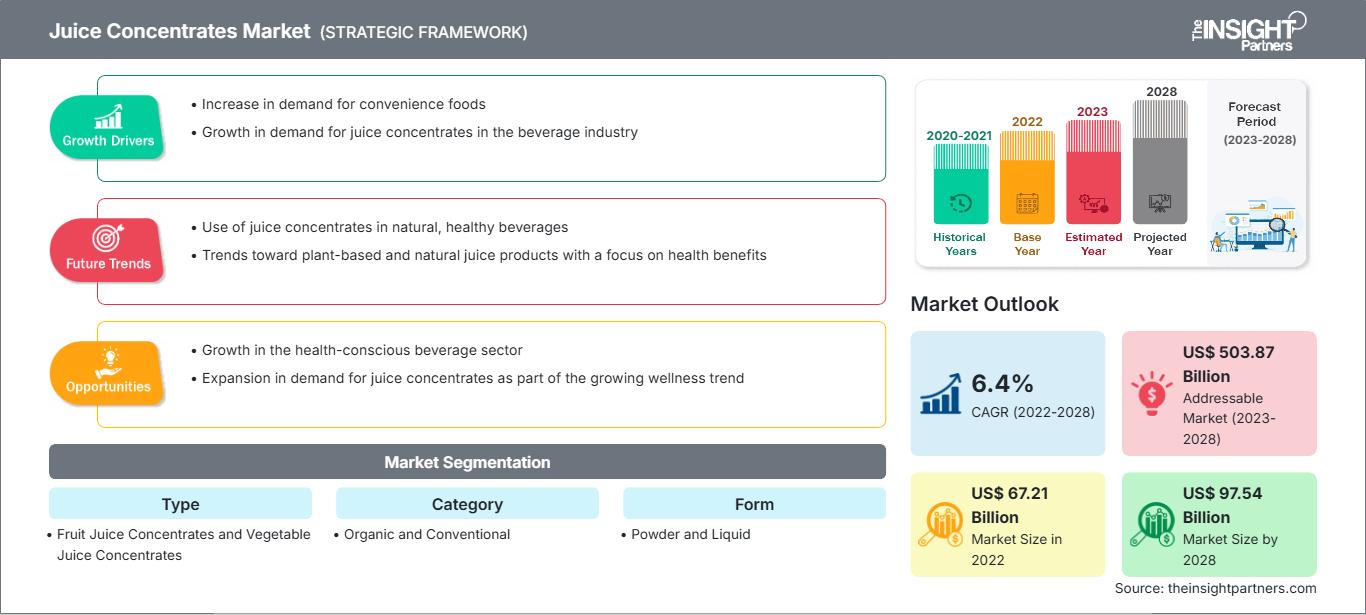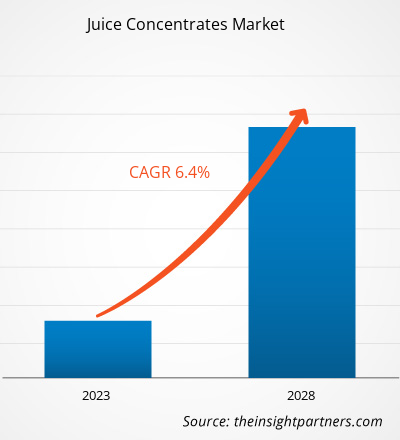Der Markt für Saftkonzentrate soll von 67.210,96 Millionen US-Dollar im Jahr 2022 auf 97.541,12 Millionen US-Dollar im Jahr 2028 wachsen; von 2022 bis 2028 wird eine durchschnittliche jährliche Wachstumsrate (CAGR) von 6,4 % erwartet.
Saftkonzentrate werden durch Wasserentzug aus Frucht- und Gemüsesäften hergestellt. Je nach Art des verwendeten Obstes und Gemüses enthalten diese Konzentrate wichtige Nährstoffe wie Mineralien und Vitamine. Im Vergleich zu Rohsäften sind die Saftkonzentrate stark verarbeitet. Das Wasser wird den Saftkonzentraten entzogen, da es das Bakterienwachstum hemmt. Die Saftkonzentrate werden in der Regel bei Raumtemperatur gelagert oder eingefroren und vor dem Verzehr in gefiltertem Wasser verdünnt. Die Fruchtkonzentrate sind reich an Vitamin C und anderen Antioxidantien, die die Hautgesundheit fördern und die Auswirkungen der Hautalterung verlangsamen. Es wird von Verbrauchern üblicherweise als gesunde Alternative zu frisch gepresstem Saft konsumiert.
Im Jahr 2022 hatte Europa den größten Anteil am Markt für Saftkonzentrate. Der Markt im asiatisch-pazifischen Raum wird im Prognosezeitraum voraussichtlich die höchste durchschnittliche jährliche Wachstumsrate aufweisen. Das Marktwachstum in Europa ist auf die Präsenz etablierter Akteure wie AGRANA Beteiligungs-AG, Archer Daniels Midland Company, Berrifine A/S, Ingredion Incorporated und Dohler GmbH zurückzuführen. Mit dem zunehmenden Gesundheitsbewusstsein der Verbraucher wird die Nachfrage nach natürlichen Produkten, die mit Saftkonzentraten hergestellt werden, im Prognosezeitraum voraussichtlich weiter steigen. Darüber hinaus steigt die Nachfrage nach fruchtbasierten Getränken für unterwegs aufgrund des hektischen Lebensstils der Verbraucher in der gesamten Region. Der steigende Konsum von Saftkonzentraten und Saftkonzentratprodukten wie Suppen, Soßen und Getränken ist auf die zunehmende Beliebtheit von Frucht- und Gemüsesäften gegenüber kohlensäurehaltigen Getränken zurückzuführen, insbesondere bei gesundheitsbewussten Verbrauchern.
Passen Sie diesen Bericht Ihren Anforderungen an
Sie erhalten kostenlos Anpassungen an jedem Bericht, einschließlich Teilen dieses Berichts oder einer Analyse auf Länderebene, eines Excel-Datenpakets sowie tolle Angebote und Rabatte für Start-ups und Universitäten.
Markt für Saftkonzentrate: Strategische Einblicke

-
Holen Sie sich die wichtigsten Markttrends aus diesem Bericht.Dieses KOSTENLOSE Beispiel umfasst Datenanalysen, die von Markttrends bis hin zu Schätzungen und Prognosen reichen.
Auswirkungen der COVID-19-Pandemie auf den Markt für Saftkonzentrate
Die COVID-19-Pandemie wirkte sich auf Volkswirtschaften und Branchen in verschiedenen Ländern aus. Lockdowns, Reisebeschränkungen und Geschäftsschließungen in Nordamerika, Europa, im asiatisch-pazifischen Raum (APAC), Süd- und Mittelamerika sowie im Nahen Osten und Afrika (MEA) behinderten das Wachstum mehrerer Branchen, darunter der Lebensmittel- und Getränkeindustrie. Die Schließung von Produktionseinheiten unterbrach globale Lieferketten, Fertigungsaktivitäten, Lieferpläne sowie den Verkauf lebenswichtiger und nicht lebenswichtiger Produkte. Verschiedene Unternehmen erlebten 2020 Verzögerungen bei Produktlieferungen und einen Einbruch der Produktverkäufe. Darüber hinaus zwangen die von den Regierungen verschiedener Länder in Europa, im asiatisch-pazifischen Raum und in Nordamerika verhängten Reiseverbote die Unternehmen dazu, ihre Kooperations- und Partnerschaftspläne vorübergehend einzustellen. All diese Faktoren haben 2020 und Anfang 2021 verschiedene Branchen behindert und so das Wachstum verschiedener Märkte gebremst, darunter auch des Marktes für Saftkonzentrate.
Vor Ausbruch der COVID-19-Pandemie war die Nachfrage nach Saftkonzentraten aufgrund des steigenden Bedarfs an Backwaren und der steigenden Produktion von Produkten mit verschiedenen Geschmacksrichtungen hoch. Nach dem Ausbruch der Pandemie im Jahr 2020 stand die verarbeitende Industrie jedoch vor beispiellosen Herausforderungen. Die Hersteller von Saftkonzentraten hatten aufgrund von Lieferkettenengpässen infolge landesweiter Ausgangssperren, Handelsverboten und Reisebeschränkungen mit zahlreichen Problemen zu kämpfen. Die Unterbrechung der Lieferkette führte zu einer Lagerung von Rohstoffen, was die Produktion und den Vertrieb von Saftkonzentraten beeinträchtigte und zu höheren Preisen führte. Darüber hinaus gab es aufgrund des Lockdowns und der Reisebeschränkungen eine enorme Lücke zwischen Angebot und Nachfrage.
Markteinblicke
Strategische Entwicklungen wichtiger Akteure fördern das Wachstum des Marktes für Saftkonzentrate im Prognosezeitraum
Im Mai 2022 errichtete die Austria Juice GmbH, ein Joint Venture zwischen der AGRANA Beteiligungs-AG (AGRANA) und der Raiffeisen Ware Austria AG (RWA), eine großflächige Photovoltaikanlage auf dem Gelände ihres Fruchtsaftkonzentratwerks in Kröllendorf, Oberösterreich. An diesem Standort produziert das Unternehmen Fruchtsaftkonzentrate, Fruchtpürees und natürliche Aromen sowie Getränkegrundstoffe und Direktsäfte für die weiterverarbeitende Getränkeindustrie. Solche strategischen Entwicklungen der wichtigsten Marktteilnehmer dürften das Wachstum des Marktes für Saftkonzentrate in den kommenden Jahren vorantreiben.
Typbasierte Erkenntnisse
Basierend auf dem Typ ist der Markt für Saftkonzentrate in Fruchtsaftkonzentrate und Gemüsesaftkonzentrate unterteilt. Das Segment Fruchtsaftkonzentrate hatte 2022 einen größeren Marktanteil, und das Segment Gemüsesaftkonzentrate wird im Prognosezeitraum voraussichtlich eine höhere durchschnittliche jährliche Wachstumsrate (CAGR) verzeichnen. Saftkonzentrat wird durch Wasserentzug aus Fruchtsaft hergestellt und enthält einige wichtige Nährstoffe, darunter Vitamine und Mineralstoffe. Durch Entfernen des Wassergehalts durch Verdampfung kann aus frischem Saft ein Saftkonzentrat hergestellt werden, das als Aromastoff in anderen Lebensmitteln und Getränken verwendet wird. Fruchtkonzentrate werden oft mit Wasser gemischt, um köstliche, erfrischende Saftgetränke herzustellen. Fruchtsaftkonzentrate werden hauptsächlich zur Herstellung von Fruchtsäften, Erfrischungsgetränken und Nektaren verwendet.
Kategorie-Einblicke
Basierend auf den Kategorien ist der Markt für Saftkonzentrate in Bio und konventionell unterteilt. Das konventionelle Segment hatte 2022 einen größeren Marktanteil, und das Bio-Segment wird im Prognosezeitraum voraussichtlich eine höhere durchschnittliche jährliche Wachstumsrate verzeichnen. Der konventionelle Anbau von Obst und Gemüse ermöglicht die Verwendung von Kunstdünger, Mist, Kompost, Klärschlamm und anderen Bodenverbesserungsmitteln. Obst und Gemüse der konventionellen Kategorie werden mit verschiedenen chemischen Düngemitteln, Pestiziden und Unkrautbekämpfungsmitteln besprüht und mit künstlichen Methoden wie gentechnisch veränderten Organismen angebaut. Daher ist der konventionelle Anbau günstiger als der ökologische. Daher sind konventionelle Saftkonzentrate günstiger als Bio-Saftkonzentrate.
Form-basierte Einblicke
Basierend auf der Form ist der Markt für Saftkonzentrate in Pulver und Flüssigkeit unterteilt. Das Flüssigsegment hatte 2022 einen größeren Marktanteil, und das Pulversegment dürfte im Prognosezeitraum eine höhere durchschnittliche jährliche Wachstumsrate (CAGR) verzeichnen. Lösungsmittel aus Obst und Gemüse sowie der gewonnene Pflanzenextrakt sind in flüssiger Form erhältlich. Dieser Flüssigextrakt kann zu Pulver weiterverarbeitet oder für verschiedene Anwendungen in den Endverbrauchsindustrien vertrieben werden. Die flüssige Form ist die am häufigsten erhältliche Form von Saftkonzentraten, da sie im Vergleich zu anderen Formen nur eine minimale Verarbeitung erfordert.
Anwendungseinblicke
Basierend auf der Anwendung ist der Markt für Saftkonzentrate in Backwaren und Süßwaren, Getränke, Suppen, Soßen und Würzmittel, Milchprodukte und gefrorene Desserts und Sonstiges unterteilt. Das Getränkesegment hatte 2022 den größten Marktanteil, und das Backwaren- und Süßwarensegment dürfte im Prognosezeitraum die höchste durchschnittliche jährliche Wachstumsrate (CAGR) verzeichnen. Saftkonzentrate finden breite Anwendung bei der Herstellung von Bio- und konventionellen Getränken wie Wasser, Fruchtspritzern, kohlensäurehaltigen Erfrischungsgetränken, Teegetränken, Biermischgetränken, Apfelwein und Spirituosen, was das Wachstum des Getränkesegments fördert. Dieses Wachstum wird auch durch die steigende Nachfrage nach immunstärkenden, gesunden und funktionellen Getränken unterstützt. Einige große Getränkehersteller wie Döhler bieten verschiedene Produkte an, darunter CO2-stabile Konzentrate, geklärte Saftkonzentrate und alkoholstabile Saftkonzentrate.
Ciatti Co, Berrifine AS, Archer-Daniels-Midland Co, AGRANA Beteiligungs AG, Döhler GmbH, Kanegrade Ltd, CitroGlobe SRL, SVZ International BV und IPRONA SpA gehören zu den wichtigsten Akteuren auf dem Markt für Saftkonzentrate. Diese Unternehmen konzentrieren sich hauptsächlich auf Produktinnovationen, um ihren Marktanteil zu vergrößern und neue Trends zu verfolgen.
Saftkonzentrate
Regionale Einblicke in den Markt für SaftkonzentrateDie Analysten von The Insight Partners haben die regionalen Trends und Faktoren, die den Markt für Saftkonzentrate im Prognosezeitraum beeinflussen, ausführlich erläutert. In diesem Abschnitt werden auch die Marktsegmente und die geografische Lage in Nordamerika, Europa, dem asiatisch-pazifischen Raum, dem Nahen Osten und Afrika sowie Süd- und Mittelamerika erörtert.
Umfang des Marktberichts über Saftkonzentrate
| Berichtsattribut | Einzelheiten |
|---|---|
| Marktgröße in 2022 | US$ 67.21 Billion |
| Marktgröße nach 2028 | US$ 97.54 Billion |
| Globale CAGR (2022 - 2028) | 6.4% |
| Historische Daten | 2020-2021 |
| Prognosezeitraum | 2023-2028 |
| Abgedeckte Segmente |
By Typ
|
| Abgedeckte Regionen und Länder |
Nordamerika
|
| Marktführer und wichtige Unternehmensprofile |
|
Dichte der Marktteilnehmer für Saftkonzentrate: Verständnis ihrer Auswirkungen auf die Geschäftsdynamik
Der Markt für Saftkonzentrate wächst rasant. Die steigende Nachfrage der Endverbraucher ist auf Faktoren wie veränderte Verbraucherpräferenzen, technologische Fortschritte und ein stärkeres Bewusstsein für die Produktvorteile zurückzuführen. Mit der steigenden Nachfrage erweitern Unternehmen ihr Angebot, entwickeln Innovationen, um den Bedürfnissen der Verbraucher gerecht zu werden, und nutzen neue Trends, was das Marktwachstum weiter ankurbelt.

- Holen Sie sich die Markt für Saftkonzentrate Übersicht der wichtigsten Akteure
Bericht-Spotlights
- Fortschreitende Branchentrends im Markt für Saftkonzentrate, die Unternehmen bei der Entwicklung effektiver langfristiger Strategien unterstützen
- Geschäftswachstumsstrategien von Marktteilnehmern in Industrie- und Entwicklungsländern
- Quantitative Analyse des Marktes von 2022 bis 2028
- Schätzung der weltweiten Nachfrage nach Saftkonzentraten
- Porters Fünf-Kräfte-Analyse zur Veranschaulichung der Wirksamkeit von Käufern und Lieferanten im Markt für Saftkonzentrate
- Jüngste Entwicklungen zum Verständnis des wettbewerbsorientierten Marktszenarios
- Markttrends und -aussichten sowie Wachstumstreiber und -hemmnisse im Markt für Saftkonzentrate
- Unterstützung im Entscheidungsprozess durch Hervorhebung von Marktstrategien, die das kommerzielle Interesse untermauern
- Größe des Marktes für Saftkonzentrate an verschiedenen Knotenpunkten
- Detaillierter Überblick und Segmentierung des Marktes und der Wachstumsdynamik der Saftkonzentratebranche
- Größe von der Markt für Saftkonzentrate in verschiedenen Regionen mit vielversprechenden Wachstumschancen
- Historische Analyse (2 Jahre), Basisjahr, Prognose (7 Jahre) mit CAGR
- PEST- und SWOT-Analyse
- Marktgröße Wert/Volumen – Global, Regional, Land
- Branchen- und Wettbewerbslandschaft
- Excel-Datensatz
Aktuelle Berichte
Erfahrungsberichte
Grund zum Kauf
- Fundierte Entscheidungsfindung
- Marktdynamik verstehen
- Wettbewerbsanalyse
- Kundeneinblicke
- Marktprognosen
- Risikominimierung
- Strategische Planung
- Investitionsbegründung
- Identifizierung neuer Märkte
- Verbesserung von Marketingstrategien
- Steigerung der Betriebseffizienz
- Anpassung an regulatorische Trends






















 Kostenlose Probe anfordern für - Markt für Saftkonzentrate
Kostenlose Probe anfordern für - Markt für Saftkonzentrate